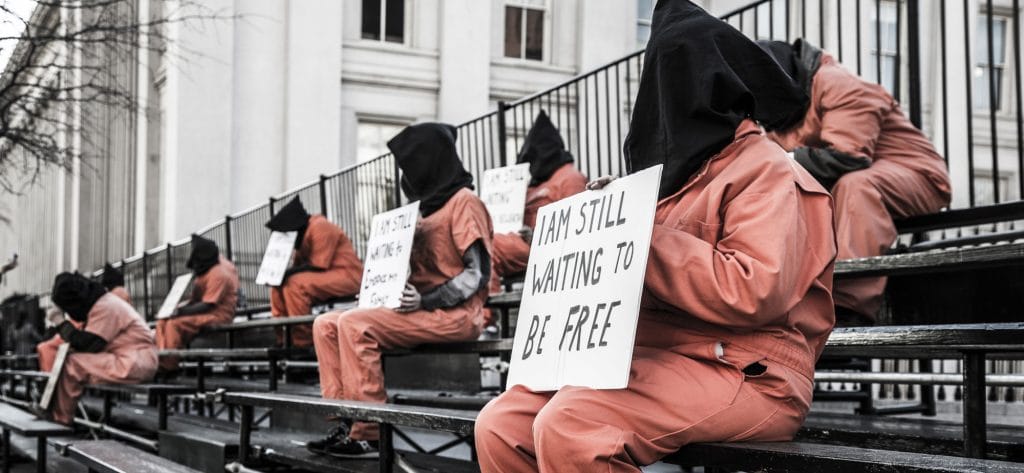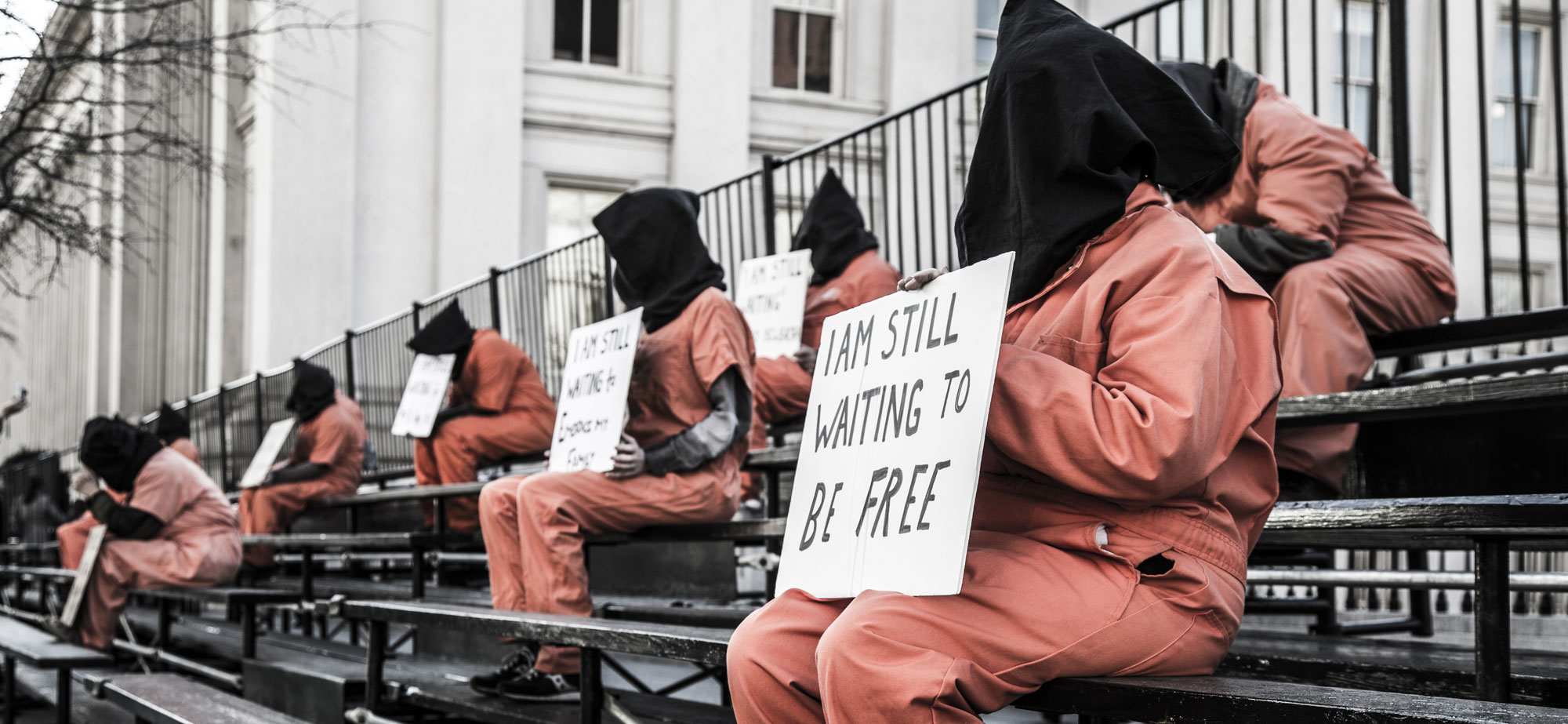In Focus
Communications Management Units: Prisons for Victims of the Domestic War on Terror

by Helen Schietinger, organizer for Witness Against Torture
A Prison Just for Muslims
When the federal Bureau of Prisons (BOP) created the first Communications Management Unit (CMU) in 2006, nobody outside the prison bureaucracy — not the prisoners sent there, not their lawyers, not the public — knew of its existence. It was a prison within a medium security prison in Terre Haute, Indiana, where Muslim men, some convicted of “terrorism-related crimes,” were being quarantined from the general prison population and cut off from their families and their communities. The CMU is housed in what had been a decrepit, abandoned building in the prison compound: the closed death row facility that formerly held Timothy McVeigh. The Center for Constitutional Rights (CCR) began researching its existence when prisoner after prisoner wrote letters to them desperately seeking help from behind bars to have contact with their loved ones. CCR then mounted a legal challenge in 2010.
When other prisoners and the outside world noticed what was happening, both CMUs (a second opened in Marion, Ohio) quickly became labeled “terrorist units” by those in the general prison population. Thus the domestic myth was reinforced that the government is punishing and segregating Muslim terrorists. In media coverage the CMUs were called Little Gitmo and Guantanamo North, given that they housed Muslim men, but this also mirrored the myth that the notorious, offshore prison is keeping “the worst of the worst” terrorists off the battlefield.
CMUs differ from Guantanamo in a very significant way, however. All the prisoners in CMUs have been convicted of crimes (many on the basis of FBI-paid informants — more about that later), while almost all prisoners in Guantanamo have never been tried or convicted. The few convictions have been in “military tribunals” in which defendants are denied proper due process.
The BOP plays a cat and mouse game to avoid having to disclose information about or close the CMUs. After being challenged on the basis of religious discrimination, the prison administration began admitting non-Muslim “balancers” to the prison: environmental activists, organizers for prisoner rights, others who might want to “recruit and radicalize others.” Thus the CMUs were expanded into prisons for political activists and dissidents. However, even today 60% of the prisoners are Muslim, while only 6% of the overall prison population is Muslim.
The CMUs were established without the requisite public notification, and prisoners were transferred to the units without being told where or why they were sent there. They were given no process by which to be restored to the general prison population. Their contact with the outside world was severely limited: they were allowed much less time than other prisoners to speak by phone or have visits from their immediate families and were denied all physical contact with their family members during visits. Communication with friends and relatives beyond their immediate families was severely limited.
As CCR began developing its legal challenges regarding due process and First Amendment rights violations, BOP made some changes, such as minimal increases in time allowed for visitation and documentation of the procedures for assignment to and discharge from CMUs. Thus, with CCR and public scrutiny the situation of CMU inmates did improve. However, implementation of these new procedures remain arbitrary or nonexistent according to prisoners’ attorneys.
CCR’s case against the CMUs returns to court this summer, having been remanded to the lower (district) court. The district court judge is currently considering whether CMU procedures violate due process, and a decision is expected any time. According to CCR attorney Rachel Meeropol, “The [appellate] court’s decision makes clear that the BOP cannot simply send anyone they want to a CMU, for any reason, without explanation, for years on end.”
What is it like in a CMU?
Prisoners continue to suffer in extreme isolation in these unique U.S. prison units. While the legal challenge drags along, several aspects of the prisoners’ situations make their lives miserable.
First, they are stigmatized as terrorists:
CMU prisoners, within the larger prison system, and their families, in the community, are stigmatized with the terrorist label, in broad brush strokes by the press and in vague but vivid innuendo by their prosecutors. The families bear the burden of the label terrorist in their neighborhoods, schools and mosques. Other prisoners and prison staff perceive the CMU prisoners as terrorists. This has a chilling effect on personal relationships, cutting them off from society on multiple levels.
Media coverage of the CMUs has led the public to believe that the government is protecting them from Muslims who must be segregated because they might otherwise commit terrorist acts, even while incarcerated. Meanwhile, non-Muslim home-grown terrorists go unnamed as terrorists on a routine basis: Dylan Roof, who slaughtered nine African Americans in their own church, or Craig Stephen Hicks, who executed three of his Muslim neighbors. (In fact, Hicks is housed in a county jail and the investigation into whether it was even a hate crime is crawling into its third year.) Jeremy Christian, who murdered two people and injured a third in Portland, Oregon while verbally assaulting a woman in a hijab, has been called a white supremacist, but major media has not labelled him a terrorist.
According to the FBI, domestic terrorism involves “activities dangerous to human life that violate state or federal law and appear to be intended to intimidate or coerce a civilian population.”. Terrorist acts against people of color and people who are Muslim in the U.S. are blatant and in-your-face, and they are not conducted in a vacuum. On June 10th there were nationwide “Marches Against Sharia” sponsored by the anti-Muslim hate group ACT for America.
Second, their rights and privileges are drastically and unreasonably curtailed:
As has been described, the government is holding CMU prisoners under more restrictive conditions and environments than the general prison population without justification based on their behavior. Their communication with the outside world is extremely restricted. For example, CMU prisoners can be limited to 45 minutes of phone calls a month, compared to 300 minutes that are allowed inmates in the Florence ADX Supermax prison. Visits can be limited to 4 hours a month, compared to 35 hours a month for prisoners in Supermax prisons. Visitors can be limited, and the visits are severely controlled and monitored. These are non-contact visits, even with family: the men are not allowed to be in the same room with or to touch, much less hug, their loved ones. All family visits are conducted with a thick plate of glass between the person and his spouse and children. All visits must be conducted in English unless permission is granted 10 days in advance. Even outgoing mail can be restricted to six pages of per month. Moreover, speech is regulated. CMU prisoners have been put in solitary confinement (called the SHU for Special Housing Unit) for complaining about their prison conditions. Finally, there is continual video surveillance throughout the facilities.
Third, many prisoners didn’t DO anything harmful:
The CMU prisoners whom I’ve read about were victims of “preeemptive prosecutions.” They were either enticed by paid informants into participating in the planning of what were described in court as future, never-enacted crimes, or they were convicted on bizarrely flimsy grounds for criminal offenses they were allegedly going to commit. These convictions have led to long sentences in federal prison. The stories of two men, highlighted in the next section, illustrate this new mechanism for prosecution.
Stories of Injustice
Yassin Aref
Let’s look at the story of Yassin Aref, a Muslim cleric who came to the U.S. with his wife Zuhur and their three children from Iraq as Kurdish refugees seeking asylum in 1999. After 2003, the FBI began monitoring him but could not find any wrongdoing. They then assigned a Pakistani informant named Shahed Hussain, known as Malik, to get involved with a local businessman named Hossain who was also a supporter of Aref’s mosque. The plan was to get Hossain to arrange for Malik to borrow $50,000 to buy a missile launcher, using a code word for the weapon, and in exchange he would receive $5,000 for his business. Aref’s sole role in the transaction was to serve as witness, or notary, to the loan, a common role for him as imam.
And this is the chilling result :
To outside observers of the case, the details that emerged during the trial were troubling. The FBI testified that Aref knew the code word, linking him to the conspiracy, but according to recorded conversations, there was no evidence that either Malik or Hossain informed him of the term. And though Malik had shown a fake missile to Hossain, the FBI decided against showing it to Aref because they worried that he would be “spooked.”
The case, observers noted, ultimately lacked definitive evidence that Aref knew the true nature of the transaction, and the jury was directed to ignore the motives of the FBI’s investigation. As Judge Thomas J. McAvoy instructed them, “The FBI had certain suspicions, good and valid suspicions for looking into Mr. Aref, but why they did that is not to be any concern of yours.”
“I’m not only surprised that the jury convicted him, but I’m sure the judge was surprised too,” says Stephen Gottlieb, a professor at Albany Law School and author of Morality Imposed: The Rehnquist Court and Liberty in America. “They basically turned two decent men into criminals.”
His attorney Manley believes he lost on emotional grounds. “I think the fear got to [the jury]. They ended up convicting him out of fear that he might be some kind of shadowy bad guy.” Steve Downs, another member of Aref’s legal team, attributes it to what he calls “the Muslim exception.” The emotion and politics of 9/11 had, they argue, altered the threshold for what constituted reasonable doubt.
Aref was convicted of providing material support to a terrorist organization by helping finance the purchase of the missile. Currently serving a 15-year sentence, he was in a CMU for four years but is now in a low security prison in Pennsylvania.
Rafil Dhafir
And then there’s the story of Rafil Dhafir, MD, an oncologist in upper New York State who ran a Muslim charity called Help the Needy (HTN) for thirteen years. It raised millions of dollars to send to Iraq’s vulnerable citizens during the time of economic sanctions leading up to the 2003 US invasion of Iraq. He was arrested and accused of terrorism related to his charity, but was ultimately convicted of violating the economic sanctions against Iraq, money laundering, and Medicare fraud. He was sentenced to 22 years in prison and served several years of that sentence in the Terre Haute CMU. Although no terrorism charges were ever brought against Dhafir, he is on the government’s list of successful terrorism convictions.
A comprehensive Truth-out article describes the use of Dhafir as an example of the government’s success in apprehending terrorists. The media hysteria was fanned by politicians and law enforcement alike:
At approximately 6:30 AM on February 26, 2003, upstate New York oncologist Dr. Rafil Dhafir pulled out of his driveway in Fayetteville, heading to his practice in the underserved area of Rome; he has never returned. Just moments later, he was pulled over and arrested by two federal investigators and a New York state trooper on charges that he had violated International Emergency Economic Powers Act (IEEPA) by sending food and medicine for 13 years through his charity Help the Needy (HTN) to sick and starving Iraqi civilians. Back at the house he had just left, Mrs. Dhafir was now standing in her entryway with five guns pointed at her head after government agents broke down the door because she had failed to answer quickly enough.
The arrests were accompanied by a media circus: helicopters hovering over Dhafir’s house and all day-reports of the comings and goings of 80 federal agents. Attorney General John Ashcroft announced that “funders of terrorism have been arrested” and Gov. George Pataki claimed the arrests proved the existence of “… terrorists living here in New York state among us … who are supporting or aiding and abetting those who would destroy our way of life and kill our friends and neighbors.”
According to a recent statement by Katherine Hughes, who has closely followed his case:
Dr. Dhafir is currently in his 15th year of a 22-year prison sentence for a crime he was never charged with in a court of law: money laundering to help terrorist organizations. His real crime was sending food and medicine, for 13 years, to sick and starving Iraqi civilians during the brutal US and UK-sponsored UN embargo on that country.
Dr. Dhafir is yet another Muslim man who was imprisoned in the CMU in Terre Haute, Indiana, another victim of the “War on Terror.”



Join us on social media